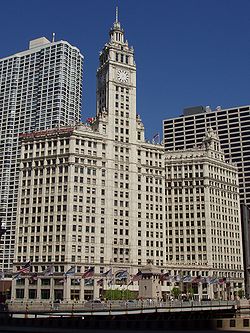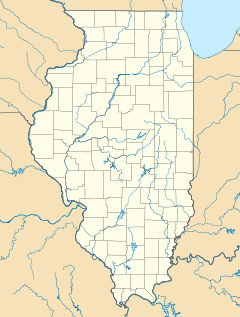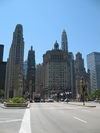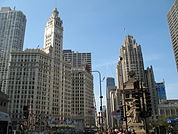- Michigan–Wacker Historic District
-
Michigan–Wacker Historic District
Location: Chicago, Illinois Coordinates: 41°53′19″N 87°37′29″W / 41.88861°N 87.62472°WCoordinates: 41°53′19″N 87°37′29″W / 41.88861°N 87.62472°W Area: 29.5 acres (119,000 m2) [1] Architect: Holabird & Roche Architectural style: Gothic, Other, Skyscraper Governing body: Private NRHP Reference#: 78001124 Added to NRHP: November 15, 1978[2] The Michigan–Wacker Historic District is a National Register of Historic Places District that includes parts of the Chicago Loop and Near North Side community areas in Chicago, Illinois, United States. The district is known for the Chicago River, two bridges that cross it, and eleven high rise and skyscraper buildings erected in the 1920s.[3] Among the contributing properties are the following Chicago Landmarks:
- 333 North Michigan
- London Guarantee Building (360 North Michigan)
- Carbide & Carbon Building (230 North Michigan)
- Michigan Avenue Bridge
- Fort Dearborn
- 35 East Wacker
- Mather Tower (75 East Wacker)
- Heald Square Monument
- Tribune Tower (435 North Michigan)
Michigan Avenue Bridge and southern part of districtNorth of Michigan Avenue BridgeOther notable sites include Pioneer Court the Jean Baptiste Point Du Sable Homesite (401 North Michigan), which as the site of Chicago's first permanent residence[4] is a National Historic Landmark, and the Wrigley Building (410 North Michigan). The district is immediately north of the Historic Michigan Boulevard District. The district includes contributing properties with addresses on North Michigan Avenue, East Wacker Drive, North Wabash Avenue and East South Water Street. Other streets in the district are Rush Street, Hubbard, Illinois and Kinzie.[3][5] The majority of these properties are on Michigan, with addresses ranging from 230 North Michigan to 505 North Michigan.[3] The district also includes parts of Michigan, Wacker and East South Water, which are all among the many multilevel streets in Chicago.[3][5] The district hosted two bridges and one monument among its contributing properties at the time of its 1978 nomination. Most of its contributing high-rise buildings and skyscrapers are of either Gothic or Baroque architecture.[3]
It was listed as on the National Register of Historic Places on November 15, 1978.[2][6]
See also
Notes
- ^ Wagner, p.8
- ^ a b "National Register Information System". National Register of Historic Places. National Park Service. 2008-04-15. http://nrhp.focus.nps.gov/natreg/docs/All_Data.html.
- ^ a b c d e Wagner, p.2
- ^ Wagner, p.3
- ^ a b Wagner, p.11
- ^ Wagner, p.1
References
- Wagner, Robert. (1978-02-03) National Register of Historic Places Inventory-Nomination: Michigan–Wacker Historic District National Park Service.
City of Chicago Architecture · Beaches · Climate · Colleges and Universities · Community areas · Culture · Demographics · Economy · Flag · Freeways · Geography · Government · History · Landmarks · Literature · Media · Music · Neighborhoods · Parks · Public schools · Skyscrapers · Sports · Theatre · Transportation
 Category ·
Category ·  Portal
PortalU.S. National Register of Historic Places Topics Lists by states Alabama • Alaska • Arizona • Arkansas • California • Colorado • Connecticut • Delaware • Florida • Georgia • Hawaii • Idaho • Illinois • Indiana • Iowa • Kansas • Kentucky • Louisiana • Maine • Maryland • Massachusetts • Michigan • Minnesota • Mississippi • Missouri • Montana • Nebraska • Nevada • New Hampshire • New Jersey • New Mexico • New York • North Carolina • North Dakota • Ohio • Oklahoma • Oregon • Pennsylvania • Rhode Island • South Carolina • South Dakota • Tennessee • Texas • Utah • Vermont • Virginia • Washington • West Virginia • Wisconsin • WyomingLists by territories Lists by associated states Other Categories:- Historic districts in Illinois
- National Register of Historic Places in Chicago, Illinois
Wikimedia Foundation. 2010.




